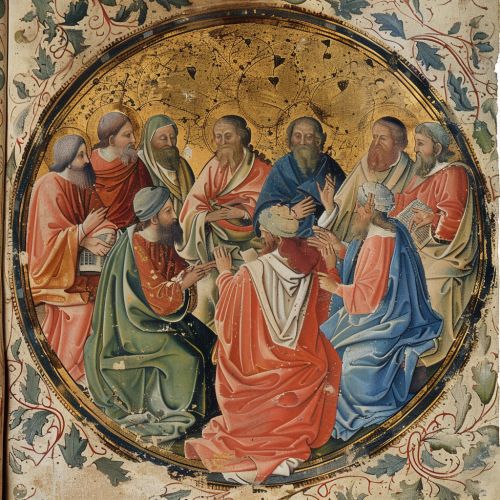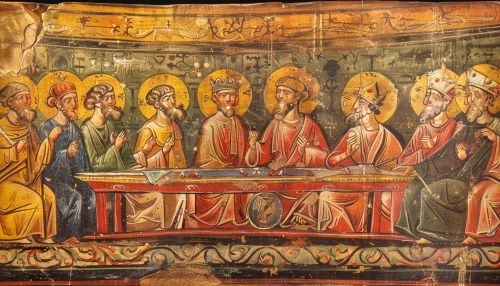Monophysites: Difference between revisions
(Created page with "== Monophysites == Monophysitism is a Christological position that emerged in the early Christian Church, asserting that Jesus Christ has a single, divine nature rather than two natures, one divine and one human. This theological stance was a significant point of contention in the early centuries of Christianity and led to various schisms and the formation of distinct Christian traditions. <div class='only_on_desktop image-preview'><div class='image-preview-loader'></d...") |
No edit summary |
||
| Line 3: | Line 3: | ||
Monophysitism is a Christological position that emerged in the early Christian Church, asserting that Jesus Christ has a single, divine nature rather than two natures, one divine and one human. This theological stance was a significant point of contention in the early centuries of Christianity and led to various schisms and the formation of distinct Christian traditions. | Monophysitism is a Christological position that emerged in the early Christian Church, asserting that Jesus Christ has a single, divine nature rather than two natures, one divine and one human. This theological stance was a significant point of contention in the early centuries of Christianity and led to various schisms and the formation of distinct Christian traditions. | ||
[[Image:Detail-91487.jpg|thumb|center|Ancient manuscript depicting a theological debate.|class=only_on_mobile]] | |||
[[Image:Detail-91488.jpg|thumb|center|Ancient manuscript depicting a theological debate.|class=only_on_desktop]] | |||
=== Historical Context === | === Historical Context === | ||
Latest revision as of 01:21, 21 June 2024
Monophysites
Monophysitism is a Christological position that emerged in the early Christian Church, asserting that Jesus Christ has a single, divine nature rather than two natures, one divine and one human. This theological stance was a significant point of contention in the early centuries of Christianity and led to various schisms and the formation of distinct Christian traditions.


Historical Context
Monophysitism arose as a reaction to the Council of Chalcedon in 451 AD, which declared that Jesus Christ is to be acknowledged in two natures, without confusion, change, division, or separation. This Chalcedonian Definition was intended to address and resolve the Nestorian controversy, which emphasized the disunion between Christ's human and divine natures. However, it was met with opposition by those who believed that it compromised the unity of Christ's person.
The term "Monophysite" comes from the Greek words "mono" (single) and "physis" (nature). Monophysites argued that Christ's divine nature absorbed his human nature, resulting in a single, divine nature. This belief was primarily propagated by Eutyches, an archimandrite in Constantinople, who argued that Christ's human nature was subsumed into his divine nature "like a drop of honey in the sea."
Theological Foundations
Monophysitism is rooted in the theological traditions of Alexandria, where the emphasis was placed on the unity and divinity of Christ. The Alexandrian school, influenced by thinkers such as Athanasius and Cyril, stressed the importance of the divine Logos becoming flesh. They argued that the divine nature of Christ was so dominant that it effectively absorbed his human nature.
The key theological argument of Monophysitism is that the Incarnation involved a single, unified nature. Monophysites often cited biblical passages such as John 1:14 ("The Word became flesh") to support their view, interpreting it to mean that the divine Logos took on human flesh without dividing into two separate natures.
Key Figures and Movements
Several key figures and movements emerged in support of Monophysitism:
- **Eutyches**: As mentioned earlier, Eutyches was a central figure in the development of Monophysitism. His teachings were condemned at the Second Council of Ephesus in 449 AD, but he continued to have a significant following.
- **Severus of Antioch**: Severus was a prominent Monophysite theologian and patriarch of Antioch. He played a crucial role in organizing and defending the Monophysite position against Chalcedonian orthodoxy.
- **Jacob Baradaeus**: Jacob was instrumental in the establishment of the Syriac Orthodox Church, a major Monophysite church that continues to exist today. His efforts helped to sustain Monophysite communities in the face of persecution.
Schisms and Councils
The controversy over Monophysitism led to several significant schisms within the Christian Church. The Council of Chalcedon's rejection of Monophysitism resulted in the separation of several Eastern churches from the Chalcedonian tradition. These churches, often referred to as Oriental Orthodox Churches, include the Coptic Orthodox Church, the Armenian Apostolic Church, and the Ethiopian Orthodox Tewahedo Church.
The Second Council of Constantinople in 553 AD attempted to reconcile the Monophysites with the Chalcedonian Church by condemning certain Nestorian writings and emphasizing the unity of Christ's person. However, these efforts were largely unsuccessful, and the schism persisted.
Impact on Christian Theology
Monophysitism had a profound impact on the development of Christian theology. It forced the Church to clarify its teachings on the nature of Christ and the relationship between his divine and human natures. The debates over Monophysitism also contributed to the development of the Doctrine of the Hypostatic Union, which asserts that Christ has two natures, divine and human, united in one person.
The Monophysite controversy also had significant political and cultural implications. The division between Chalcedonian and non-Chalcedonian Christians influenced the religious and political landscape of the Byzantine Empire and the broader Christian world. The persistence of Monophysite communities in regions such as Egypt, Syria, and Armenia contributed to the rich diversity of Christian traditions.
Modern Perspectives
Today, the term "Monophysite" is often considered pejorative by those who hold to the belief. Instead, they prefer terms such as "Miaphysite" or "Oriental Orthodox," which emphasize the unity of Christ's nature without denying his humanity. The Oriental Orthodox Churches maintain that their Christology is consistent with the teachings of the early Church Fathers and the Council of Ephesus in 431 AD.
In recent years, there have been efforts to bridge the theological divide between Chalcedonian and non-Chalcedonian Christians. Dialogues between the Eastern Orthodox Church and the Oriental Orthodox Churches have led to a greater understanding and recognition of the shared faith and common heritage.
Conclusion
Monophysitism represents a significant chapter in the history of Christian theology. Its emphasis on the unity of Christ's nature challenged the Church to articulate a more precise understanding of the Incarnation. Despite the controversies and schisms it caused, Monophysitism has left a lasting legacy in the diverse traditions of Christianity.
